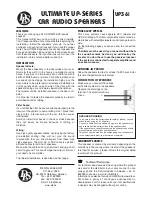
11
English
Studiophile
TM
CX8
User Guide
About the Rear-Panel EQ Contour Switches
These switches allow you to tailor
the EQ curve of your CX monitors
to complement the frequency
response of your studio.
Since studio monitors (including
the CX series) are designed to
have a flat frequency response, you may be wondering why these speakers include
additional EQ switches. These switches are included for three reasons:
1. Size, shape, and acoustical treatment of your specific studio:
CX monitors are tested and tuned in an anechoic chamber to be as linear (flat)
as possible. This means that leaving the switches set to their default settings will
closely resemble the printed acoustic frequency response graph (see Appendix)
when monitoring takes place in an “ideal” environment similar to those found in high-
end recording studios. In these studios, acousticians carefully determine the size
and shape of the control room, placement of the studio monitors and large furniture,
construction materials of the walls and ceiling, as well as all acoustical treatments
that must be applied to various parts of the room. All this ensures that studio
monitors will sound as flat and accurate as possible at the “mixing position.”
In the real-world, however, most project and home-based studios are set up in
preexisting rooms where the size/shape of the room cannot be easily modified to
improve acoustics. This means that the design of the room itself may have adverse
effects on the frequency response of the monitors (i.e, sound reflections from flat
surfaces in the room may cause the monitors to not sound linear). For that reason,
the CX line features “corrective” EQ switches to compensate for adverse effects
that may be caused by your room.
2. Placement of the CX monitors within your studio:
The proximity of your CX monitors to the walls (and floors/ceilings) may adversely
affect the frequency response of what you hear at the mixing position. This is
because all speakers radiate low-frequency sounds in all directions—not just toward
the mixing position. If there are large, flat surfaces (such as walls or ceilings) within
one foot of the speaker, these surfaces act as low frequency “sound reflectors” that
return bass energy projected from the rear of the speaker back into the studio. This
can result in bass that sounds “tubby” and exaggerated.




































